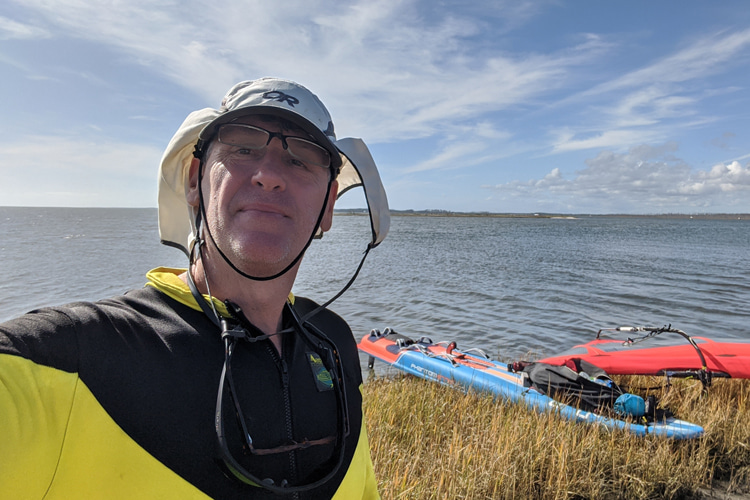Sometimes, we all need - and deserve - a second chance. Tony Vandenberg, also known as Bermudaboy, proved that determination pays off.
Vandenberg is a windsurfing marathoner. He loves sailing long distances in extreme environments.
He has once again participated in the WaterTribe North Carolina Challenge, an unsupported, expedition-style adventure race for water sports enthusiasts.
Here's how Bermudaboy lost the first game but returned for redemption and glory.
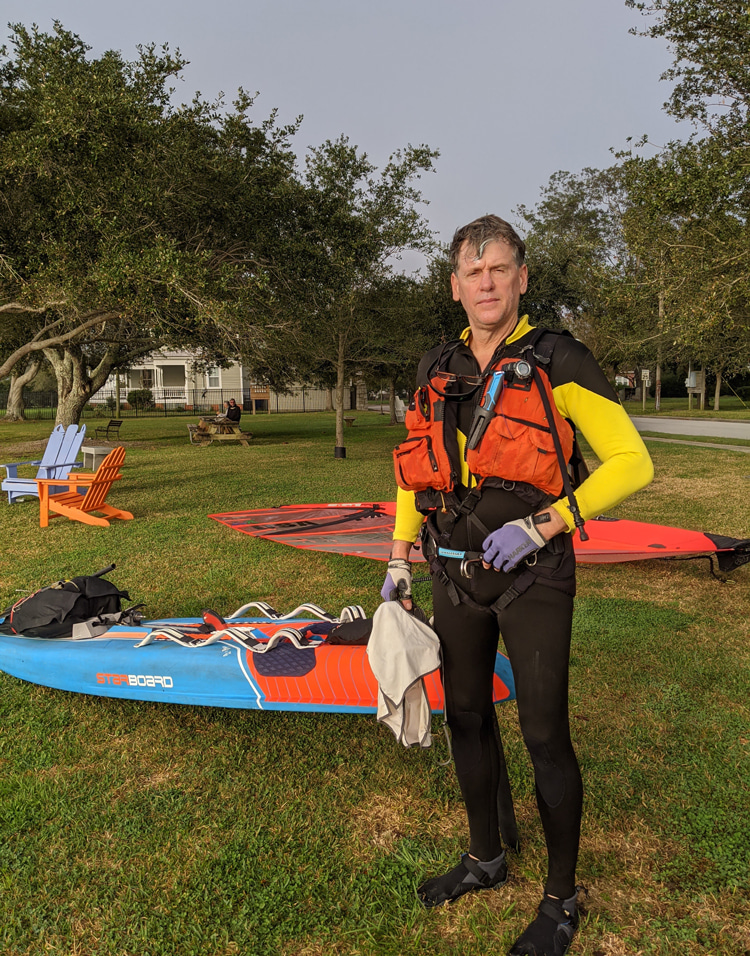
Part 1: The Loser
The WaterTribe North Carolina Challenge (NCC), if you can do it in a straight line, is just a little less than a 100-mile circumnavigation of the Carteret/Craven County peninsula, including at its top, Cedar Island, all being surrounded by the Neuse River on the west, the Pamlico Sound to the north and Core Sound on the east.
Two narrow waterways, the Harlowe and ICW at the base of the Peninsula, are the two canals that allow you to keep your feet wet all away around the Challenge.
The WaterTribe is a loose group of semi‐crazy dreamers and adventurers that inspire their fellow colleagues (Tribers) while testing their skills and determination in small crafts in coastal races from 100‐300 mile length, with 3‐4 events held annually, ranging from the Chesapeake to the Florida Everglades.
Absolutely no help or support from shore is allowed from family or friends, although other participating Tribers may assist each other out on the water.
You must carry all your spare parts, camping gear, and food/water provisions.
For a windsurfer on a Raceboard, the hardest decision is what size sail you rig up because there is ain't room for two.
This year's start was scheduled for Thursday, October 29, 2020.
However, with Hurricane Zeta coming ashore Wednesday in Louisiana as a Cat 2 and its strong wind system set to twirl diagonally across North Carolina thereafter, the event was moved forward a day in hopes of avoiding the gale conditions.
So Masami, my lovely wife, and shore contact, and I arrived late Tuesday night, with a full moon guiding us up to the storybook haven chalet.
That being the Neuse Suites Inn, which is splendidly nestled on the waterfront of the Neuse, in a small fishing village called Oriental.
My plan was to get an early start Wednesday morning and make as much distance as I could, dreadfully knowing the wind forecast for the next day and a half would be the proverbial "calm before the storm."
Making distance was going to be like, you know, kinda, well dude, Testudinidae at best.
Windy.com was forecasting Thursday evening 5ish: a pucker up and say‐your‐prayers 25‐30-knot wind with 40 knots plus gusts.
And more wind‐terror beyond for the next three days.
I was nervously wishing the forecast was bunk.
There was no way I was going to last more than a few tacks on a 3.8-meter Raceboard, loaded with 12.5 kilograms of gear/food and three liters of fresh water in those kinds of conditions.
Not to mention my engine is a 9.5 m2, deep draft, four-cambered course racing sail.
Even if I dropped the 1.7 m2 sail reef out of my sail's head and down‐hauled till the cows blew home, I would still be overpowered and immediately blown to Nowherezville and right smack into a Coast‐Guard‐What‐A‐Bleepin‐Moron‐SAR‐Sortie.
Here is a good time to shout out a big thank you to Starboard's Svein, Remi and team, for halleluiah‐ously mating my feet onto the absolute finest, fastest, stylish, and most versatile sailing craft on the planet, with unbelievable performance in the largest range of wind conditions - the 3.8-meter, 377 L Bat Wing Phantom Raceboard.
Wednesday morning at 6 am, the Neuse River looked like a sheet of glass, without a single ripple or hint of wind.
I agonized over whether to lay my sail over the stern or break it down and secure it tightly on the deck.
As there was no wind, I would not be sailing, at least in the morning hours.
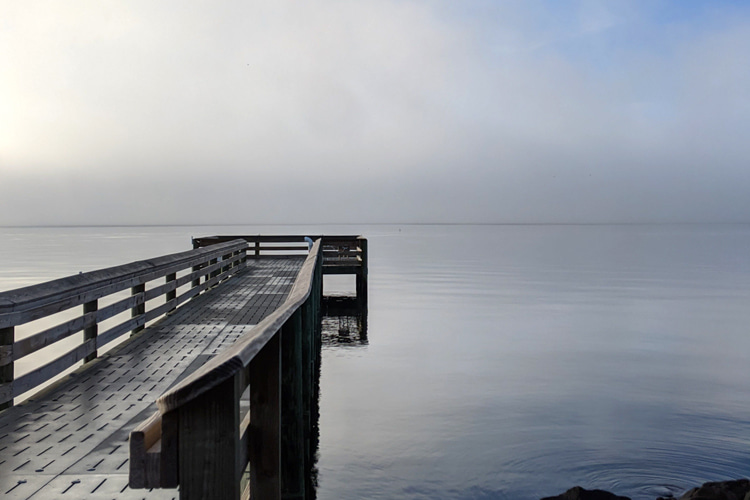
The simple lay down, balance boom on the stern is a much better option if the wind does choose to make its appearance.
That mode allows you to begin sailing right away should the wind start blowing.
The drawback is boat wakes, or worst yet, if the boom is tied down to prevent the wake, wash the sail off-board risk, and you get a momentary gust out of nowhere, from the worst possible direction - it can instantly flip you and the entire board over turtle.
Re‐righting is quite a chore involving treading water while releasing the tie-down, lifting and balancing back a nine-kilogram wet rig atop the deck, then keeping that in position and securing again.
At night in the dark, in a primordial canal with crocogators and bull sharks, I can confidently do the entire correction maneuver in 2.5 seconds; out in the middle of the Neuse in bright sunlight, let's say about 24 minutes.
I started the event with my sail just simply laid alamode with no securing.
I paddled out about 100 meters before worrying about how long I actually may have to paddle on this glass sheet, and banged a U'ie, and quickly returned back to the non‐slippery‐soft‐as‐pillows jagged rocks, and broke the sail/rig down, and secured to the reaching foot straps.
As fate would have it (how come she gets everything?), I would not see or feel a whisp of wind until about eight hours later, so thank goodness I made this correction early.
To observe physical distancing, all Tribers were starting from different locations on the Oriental coastline, and we were to cross the start at a designated GPS coordinate about 1⁄4 nautical miles offshore and then push our spot locater beacons, which would send via satellite to the race committee a signal of our time across the line.
My GPS and spot were now packed behind me, and I figured, thinking about how I would survive the horror forecast was slightly more important than pushing electronic buttons and following the rules.
So I cheatingly eyeballed a little shy of where I reckoned the start line was and started paddling diagonally across the Neuse River (more like the Long Island Sound to me) toward the entrance of Clubfoot Creek (more like a midsize Buffalo Bayou to me).
The Neuse was very peaceful and beautiful, but it was also very grinding on my Yowamushi mind.
The whole point of leaving a day earlier was to make a good distance before the storm winds arrived.
Then if necessary, sit out a day and at least finish the event once it had calmed down a bit.
Last year, in a similar slightly longer race called the Shackleford Challenge, I had made it halfway through the course when my brand new 100 percent kevlar‐carbon mast broke in half in less than eight knots of wind, and I had to DNF and paddle home.
That failure was still fresh in my mind.
Having to paddle the Neuse, plus Clubfoot Creek and the Harlowe Canal was going to take a whole lot of time and energy and produce very little progress around the circuit.
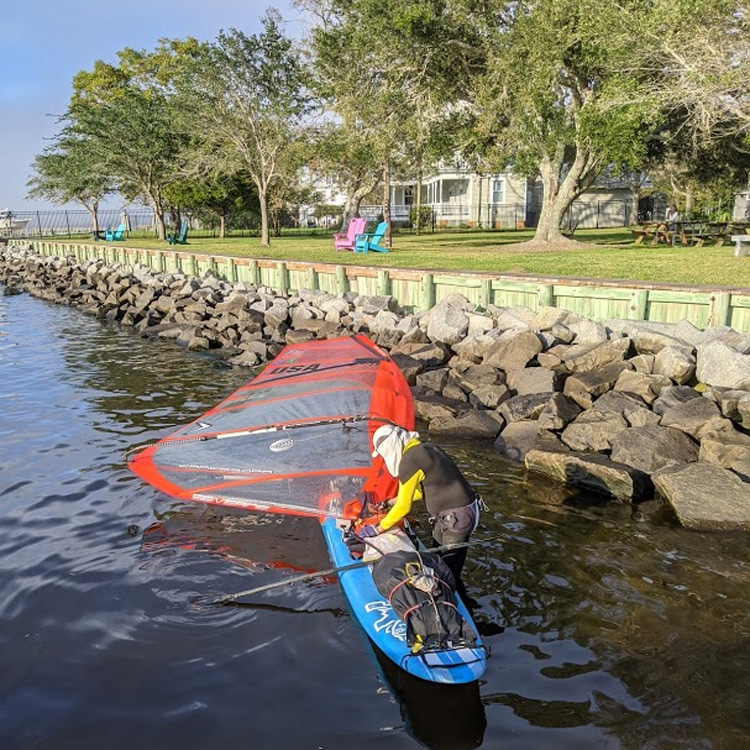
I was blessed in the first half forest area of Harlowe Canal with a half knot current licking my stern and increasing my speed over the ground, but the second half marsh area was not so kind.
Its peanut butter mud bottom kept playing buddy‐buddy and sometimes worse, lovey‐dovey, with my 52-centimeter deep race fin.
The lovey‐dovey times forced me to power paddle like I was plowing the field that used to be there before they dug the Harlowe Canal in 1815.
I am seriously moving slower than a 1/8-inch worm, and my arms are engaged in full Cummins diesel paddle torque mode.
With only about 400 meters left before I would escape the Harlowe into the only slightly deeper waters of New Port River (which feels more like Boca Ciega Bay to me), it got so shallow that I had to stop and change to my short draft weed fin.
Somewhere, in the process of taking off my race fin, unpacking the weed fin, and making sure I didn't lose my driver, screws, and washers, my weed fin fancied himself adventurous, and Jacques Cousteau-ed off the bow without his Aqua Lung.
Shuffling my feet and hands around in the muddy waters exactly where he had dived in produced multiple blind‐hard‐bump‐that‐gotta‐
be‐it contacts, yet all turned out to be only the extended nuclear family of the oyster cluster clan.
I stopped molesting the innocent mollusks after 17 minutes and then just put back in my race fin.
Luckily only having to have to walk the board much less than the 400 meters I had guessed.
Hi‐Hoo! Now, there was wind!
Well, maybe not real Hi‐Hoo wind, but at least six knots or so of a gentle breeze.
In any case, I was blessed to leave the Harlowe Canal under sail and beat my way upwind to the approach of the Beaufort Bridge.
As I made it up to the entrance channel, I was greeted by a strong head current and struggled mightily to get under the bridge against the concentrated current and its twin brother, the large wind shadow of the bridge.
After barely making it under the bridge, the wind completely shut off to zero.
I was forced to pump the sail and get her to crawl diagonally across the current to a little shallow area where I broke down and secured my sail on the stern - again.
To paddle from the bridge into Taylor Creek and then to checkpoint one on the waterfront of Beaufort took another 1.5 hours against a ripping current and atop a teeny yellow GPS track distance that a lazy crow would walk instead of fly.
I set up my small tent, boiled water for my freeze-dried beef stroganoff, and got all my equipment and water re-stocked in hopes that the wind would return around midnight, and I would sail up to at least Davy or Sealevel, both of which were about midway of the Core Sound.
I figured it was too much a waste of energy to paddle anymore with such little progress and better to rest a bit in my tent and wait for the wind to start up again.
Garfish in a trimaran, who had passed me while I was trying not to get sucked back under Beaufort Bridge, had left checkpoint one just as I arrived, and we encouraged each other in the switcheroo.
I thought he had been pointing very high earlier, and he informed me his Tri had a peddle drive.
Urgh, I wished I could carry one of those!
If I remember correctly, the last time we met was during an event several years ago when the forward crossbar on his trimaran had snapped in two at the entrance into Chokoloskee, the last piece of civilization before entering the Everglades.
Other Tribers dropped in throughout the evening and encouraged (scorned) me to get back onto the water, but to each, I embarrassingly offered the same response:
"It's not worth going out into the Core Sound without any wind."
From another incoming Triber, I learned that the storm's wind forecast had taken three suicide turns for the worse - faster winds, more days of fast wind, and the gale would be arriving seven hours ahead of the forecasted schedule.
All worst possible case scenarios.
As usually happens in public areas, people enjoying the waterfront drop by and chat when they see a windsurfer in the shallows unloading a battleship of gear.
I think I blabbered more than I should with a number of folks that evening.
All was good, and the folks were kind and encouraging, but I was trying to cut off the conversations as I had not given up yet and wanted to get into my tent and be alone to let my mind spin on what might be possible and pray that the forecast yet might change to the better.
I woke up at 5 am to check the forecast on my mobile and check the actual wind on the skin of my face, and both were exactly what I was hoping they would not be.
I called Masami and asked her to come to meet me here at Beaufort's Henry C. Chambers Waterfront Park.
My race was over, or maybe just weather-hold postponed. I was not going to go launch out into the Core Sound in these conditions.
Even though I had only paddled about 23 nautical miles yesterday, in a car from Oriental, over land, it takes slightly over one hour and 45 minutes and 70 miles, so I told her to take her time, there was no longer any rush, and that I looked forward to seeing her around 7:30 to 8.
I started a Living-Dead speed cleaning up and packing my gear in the predawn darkness.
About 30 minutes later, the bright lights of an approaching car were blinding me, and the car rolled right up into the parking space just in front of where I was rolling up my sail on the sidewalk to avoid getting beach sand in the mix.
Out came a lovely, charming, and very kind angel, with hot coffee, fresh orange juice, a melting‐hot homemade egg/toast sandwich, and a fresh banana!
She had been one of the folks that I chatted with last evening.
She had worried about me getting back out onto the water with an empty gas tank!
I embarrassingly had to inform her that I had pretty much abandoned the race because of the horrible forecast.
I rudely devoured her generosity (although she ended up eating the banana, only politely, so I wasn't the only one munching!) two hours later after sharing all sorts of unforgettable stories of life (turns out we are both the same age) and our addictions to the outdoors and water adventures.
It was like we had just re‐met as long last friends from college.
We both laughed about how ironically her name rhymed with what I had wished for the day before, but this morning had too much to contend with: Wendy!
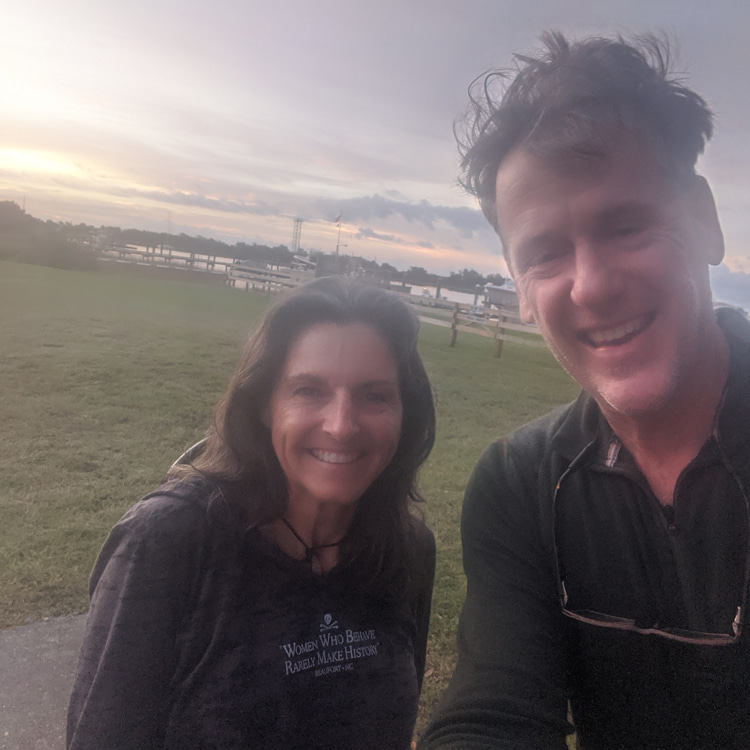
Later that evening, I jested with two of my Triber friends Purple Haze and Left Boat, who had made it through the Core Sound to checkpoint two, while I was still in my tent, but had reached the same decision to terminate at about the same time.
Perhaps I had lost the race but had won the event, as I was the only Triber to have been brought a delicious, home-cooked breakfast by a beautiful, enchanting Beaufort mermaid at the crack of dawn!
I'm still not sure if she got back in her car or slipped into the water.
Masami met me at the park bench with all my gear stacked, and I was a shrunken, lonely, lost puppy.
We got the gear loaded up and then spent a gorgeous time enjoying lattes and pastries while leisurely strolling along the Beaufort Waterfront.
We even took silly memorial snapshots with me shamelessly in my undeserved/unearned 2020 NCC event t‐shirt.
Except I realized later that I had the wrong shirt on!
As we completed the two-hour trip back to our sanctuary on the Neuse, I told her I thought it would be a good idea if I took a nap before dinner, and just then, the phone rang from - you guessed it - Purple Haze and Left Boat.
They were calling for extraction from the cove on the West Bay side of Cedar Island.
Masami got to take a nap, and I got to spend the rest of the afternoon proudly and happily assisting my buddies.
I could not believe the wind conditions when I arrived at where they had made their last stand.
I think it is the first time in my life I have seen a 25-knot wind racing across the water get completely run over and flattened out by a 45-knot monster gust.
That evening as we sat down for a delightfully Oishii seafood dinner right on the boardwalk of Oriental's indescribably picturesque fishing port.
Masami made me forget - if only for the evening - what my head knew, but my heart would not accept.
The rest of the evening, we fiddled away, sipping cocktails, as the sky faded from brilliant purples to relaxing shades of black, all the while, the howling gale winds serenading just the two of us with the strumming of the moorings, halyards, stays, and shrouds.
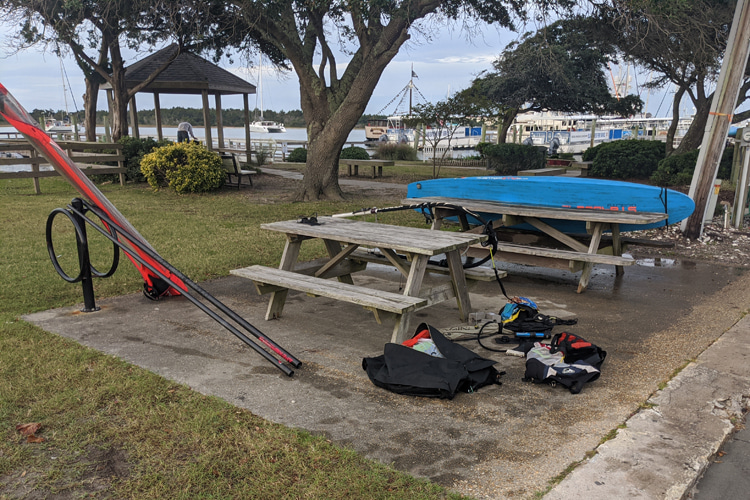
Part 2: Redemption
Thursday evening around 8 pm, less than six days from returning home from Beaufort, I told Masami that I just had to return back to the Core Sound and finish it right.
I had to get back on my board.
Her unease and worry were like a thick, impenetrable fog, but after only a few no way'z, she acquiesced on the condition that I find a new shore contact, as she would not be joining me this time.
I immediately called in a favor to Purple Haze, who lived in Emerald Isle about an hour south of Beaufort.
He had other plans, like running a continuous marathon for 24 hours for charity, but his daughter kindly agreed to take on the monitoring role.
That gave both Masami and I a big piece of mind, which I am forever grateful for.
It's Friday night, about 8 pm, and I'm driving 70 mph and heading to the top of Cedar Island, where I will challenge my solo redemption.
I will not be restarting from where I left off.
I am going to redo the entire circumnavigation of the Peninsula. I will not start this time not from Oriental, but from just beside the ferry at the top of Cedar Island that carries folks out to Ocracoke Inlet on the Outer Banks.
My plan is to go around the Ferry Pier, head west across along the coast of Cedar Island, duck into West Bay, hug the Navy Air station bombing range on Piney Island just outside the No‐Go perimeter, cut through Old Canal and South River into the Neuse, skim between the two jutting capes, enter into Adam's Creek through the ICW into Core Creek to the exit New Port River, under the Beaufort Bridge and past checkpoint one and out Taylor Creek, and then camp somewhere on either on Harker or Brown Islands.
This will put me at the mouth of the Core Sound for my Sunday morning start, and I should be able to tack upwind all day and make it back to my car parked on the backside by the Cedar Island Horse Stable before 2 pm.
The wind forecast looks great - two days of NE 10‐15 knots - with Sunday gusts into the low 20s.
Saturday will start with a beam reach, and then most of the day, morphing from broad reach to straight downwind; though once past Beaufort, some beating upwind to one of the bailout campsites that I hope to reach within a few hours after sunset.
As always, just before a race, my mind begins torturing me with all the most terrible things that might go wrong.
It seems that the more challenges I complete, the more I'm afraid of my own fear and failure.
It's so weird that I never worry about the real stuff that could shut the lights off.
Back to me, still driving down Route 101, Friday night.
I am not too far from crossing the bridge over the same Harlowe Canal that I paddled under just a few short days ago.
Funny how I hated that canal - paddling and cursing like hell to get out of it - but now, just the notion of it ahead brings only a strange joy and fond nostalgia.
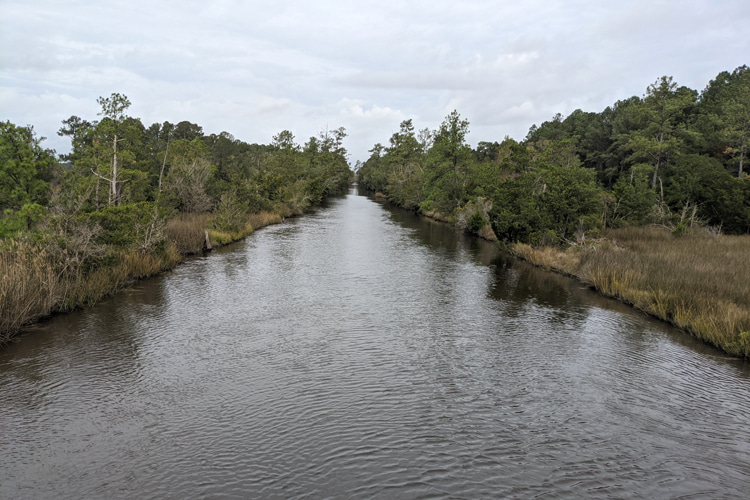
There is a truck pulling a utility trailer ahead of me.
He's weaving a little, and we're both breaking the speed limit.
As we approach a tight curve, it looks like he is going to cross the center two solid yellow lines.
Bkuuurl! Gablaaam!
The side of the oncoming car and trailer explodes into a cloud of projectiles, instantly bashing into my bumper and hood and bouncing off and over the windshield toward the roof.
My beloved Raceboard is on the roof!
I'm camp beside the horse stables and have forbidden myself from checking the condition of my Raceboard until tomorrow morning.
It's a wonderfully beautiful night with a stiff wind off the long fetch of the Pamlico Sound.
There are a gazillion stars in the sky, so many and so bright that it's making it pretty difficult for me to locate even the easiest constellations.
As I drop away into sleep, my two me's are locked in the familiar battle: "you love doing this, and it's going to be awesome, dude" versus "jeez, this is so freaking stupid, you won't make it - just quit now and go home in the morning."
Woooow! The silver and orange lined cloud edges, trying to hold down the sun's rise, are incredible.
I am all alone with the wind and water, and the first ferry to Ocracoke is now just a dot on the horizon.
My bow is just fine with only a small chip of paint and nothing more.
Sailing today has been a mix of conditions - some good broad reaches with planing speeds, but mostly downwind in 2‐3 chop in West Bay grinding on my hips.
The flat waters on the Neuse with really slow downwind legs. Not many realize, but you get extremely hot when running with the wind.
I'm just now, for the first time ever, sailing into Adams Creek and the ICW to Core Creek.
Like the Harlowe, this waterway cuts through the Peninsula to just west of Beaufort.
The first half is about half-mile wide with only natural forests on both sides, but plenty wide enough to sustain the good wind, and I've gotten some long in the forward "beating" straps, 13-knot beam reaches.
The narrow ICW part is very different than I had expected.
It has a high clay/earth bank on its north side and shoreline of jagged rocks and tall, off-the-water residential docks on its south side.
There is nowhere to pull out to take a break or switch over to paddling mode, without treading water, in a canal full of some really big moving vessels.
Two miles to the 101 ICW bridge, where I also understand its name changes to Core Creek, the wind has just about totally died, and I am pumping the sail and exerting a ton of energy to make very slow forward progress.
I'm on the verge of considering breaking down to paddle mode when I realize the tidal current is ramping up against me.
I call out to a couple sitting on their dock, asking if I can approach and get some water.
They kindly wave and welcome me in, assisting me with my water provisions and providing much-needed human encouragement and socializing.
I decide to see if I can pump my way at least to the bridge, and then I'll decide my next course of action - or desperation.
Now I know I'm in a predicament.
The ICW bridge is still around a mile away, and the current on my nose is getting worse.
Somehow I must make it at least to the bridge and decide what to do.
This feeling of nothing-to-do-but-push-on is taking its toll on me. I'm not a paddler, I'm a freaking windsurfer!
Then just ahead and right adjacent to the bridge, I spot the first boat ramp (or any bailout point whatsoever) I've seen on this entire ten nautical mile stretch of the waterway.
I'm trying to find the manager of the place, to ask if I can pitch my tent and stay to just the wee morning hours.
I had thought that there would be lots of the normal, natural sandy shoreline spots along the waterway that I could camp at in such conditions, and I had not planned for that not to be the case.
A kind couple who had just trailered their boat helped me contact the away owner of the Core Creek House Boat and RV park, and he kindly agreed for me to drop $20 in the office mailbox to pitch my tent by some forest line location that I didn't quite understand.
So, instead, I set up camp just aside from the boat ramp, only a foot from the water that I could see from my flyless tent through the reeds.
I'm surprised to look at my watch for the first time today and see that it is only 4 am.
I just talked with Left Boat in Virginia, and he has confirmed my take on the next high tide being just before 1 am.
I'm giving it a little before starting to flow out and set my alarm for 2:50 am, and then I'll get up, make breakfast, pack gear, and be on the water by 3:15 am.
There's a big dolphin not more than 20 feet away from my tent, and I'm curious about what he's up to.
He keeps diving down in the same spot, then releasing thunderous bubbles, then shooting up and smacking his tail on the surface; he's done it now about four times as I drift off to sleep.
The canal is like glass at 3:20 am, not even a faint zephyr; the tide isn't going out yet, but it certainly isn't coming in!
Hip hip hooray.
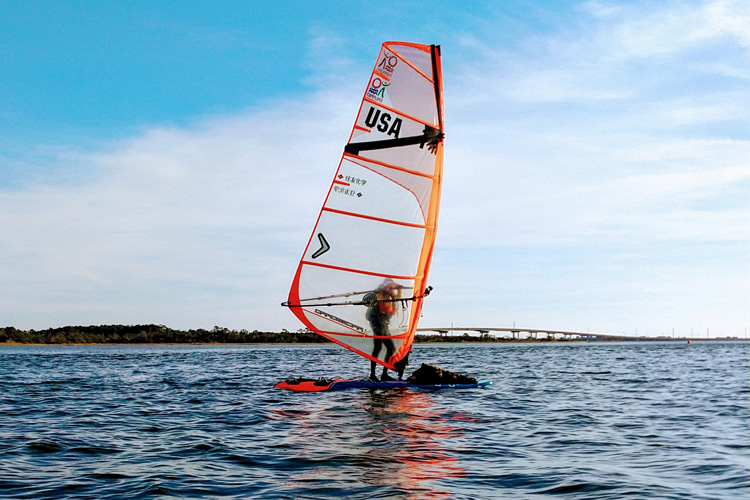
I wasn't woken by my alarm, but by Flipper doing his routine extra loudly around 2:30 am.
It didn't matter, though, as I was not sleeping soundly but half-dreaming of calling an Uber to pick me up so I would never have to paddle a Raceboard again.
I'm standing waist-deep in the water of the boat ramp, trying to get my sail balanced across the stern and fasten it down to the foot straps.
Since I put the board in the water this morning, there have been two monster size marine construction ships that have come thumping down the canal, sounding more like freight trains than vessels, and creating unbelievable tsunami wakes.
The first wake has just about washed us both back up to the top of the ramp.
So I'm putting extra care in the balance and tie‐down.
The last thing I want to do is get pitched into this mirrored black canal, run over by a marine locomotive, and eaten as an early morning breakfast.
I've finally got the sail balanced and boom secured, and I'm paddling under the bridge and officially now paddling south on Core Creek.
It's only a few miles until I reach the mouth of the New Port, but now I'm feeling quite cheated by how many potential sandy - above the tide mark - bailout campsite spots I see along the west side of the shoreline, just a few hundred meters past the bridge.
And no noisy dolphins in front of them either.
Sun isn't up yet, and I've made it under the Beaufort Bridge, and I'm in Taylor Creek's 2.7-nautical-mile narrow lane between the city waterfront and the environmentally protected Carrot Island.
I'm pinching as hard as I can on each random wind lift and, each time, I miraculously make it back to the center of the Creek.
Ten or 20 minutes later, I'm right back against the leeward shoreline's oyster beds, repeat, repeat, repeat.
Now I'm sure I'm going to make it all the way through and out Taylor Creek on a single port tack!
Just as I exit, the sunrise is again magnificently beautiful, and I can't help but start humming John Mayer's "3 x 5".
"You should have seen that sunrise with your own eyes."
The wind has been good and steady in the Core Sound, and I've been in the beating straps with board gliding on the rail almost since passing Brown Island.
The NE wind has over a 40-mile fetch to create a pretty choppy surface on the Core Sound.
My legs have been acting as the shock absorbers, and my arms pumpers in order to time the clearing of the bow over the crest of each new attacking chop.
It's a dance that never stops, and when timed just right, let's you keep your boat speed from stalling.
It is a perfect day for sailing.
As for wildlife, I've seen tons of seabirds and quite a few thrashing surface attacks on baitfish, but no other wildlife, fish, turtles, rays, sharks, or Flipper's buddies.
I've been making good Velocity Made Good (VMG) and feeling great, so instead of lying to myself like I usually do by saying, "I'll stop up there for sure, and then keep going when I get there," I seriously commit this time that I'm actually going to stop and make a nice hot lunch of Mountain House lasagna.
I'm on a starboard tack and pointing to a little cape of Salters Lumps about 2.5 nautical miles SW of the fishing port village of Sealevel.
The marsh reed-lined bank has just a few meters behind it a pristine white sand beach surrounded by hurricane-ravaged bare trees.
This will be a perfect place to stretch out, warm up, and get some warm food.
I'm about 20 seconds from reaching the point on a beam reach, and my plan is to jump back on the stern and ride the bow up onto the marsh reed bank and just jump off at the last moment without getting my feet wet.
Suddenly, a massive - must be six-inch diameter - sea turtle's head pops out of the water, immediately followed by her left front fin clawing up on the reed bank, at the very spot I am shooting for.
And almost within the same moment, her head rotates back toward me, and in a split second, she has already completely disappeared below the surface.
My forward momentum carries me over where she submerged and rides my bow right up atop the marsh reed cushion slip.
I'm wondering how in the world this giant sea turtle and I were both planning to haul out of the Core Sound at the exact same spot, at exactly the same time!
Really unbelievable!
And then, I also realize I also made it up on the bank without getting my feet wet, which surely deserves extra credit points.
Just behind the marsh reeds is a little meter-wide muddy creek with busy snails and minnows oblivious to my awe of what just happened.
And now I'm Connor McGregor's arm flopping‐leg, strolling up the little white sand beach called Paradise as if I just won UFC 299.
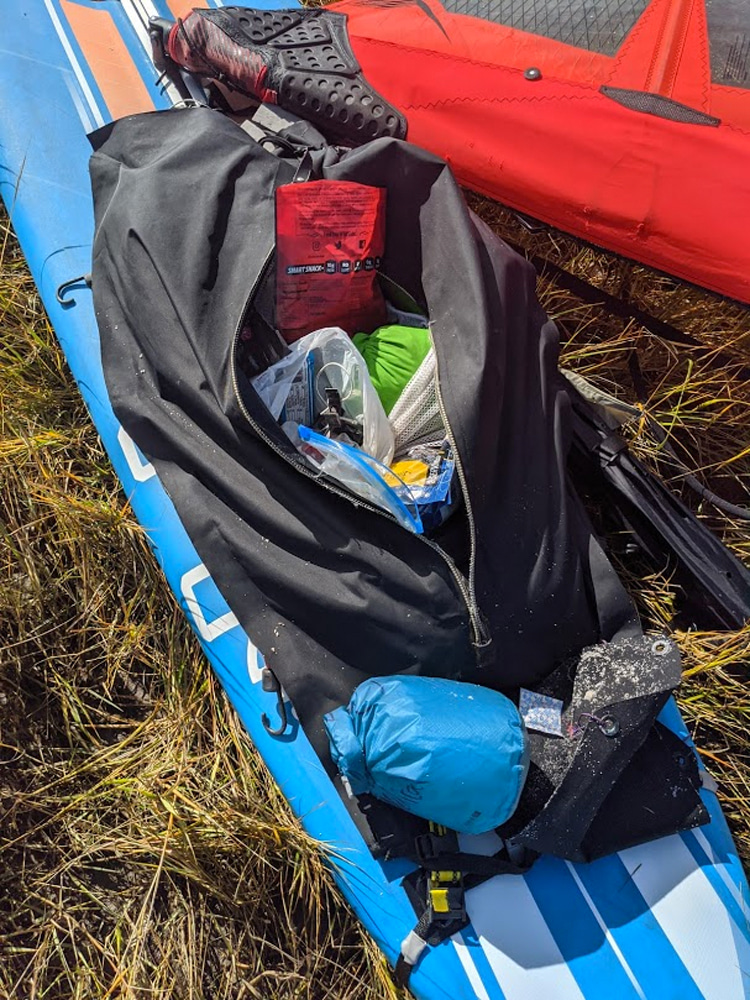
After finishing up lunch, and a few chocolate power bars for dessert, I'm wondering from the turtle's point of view - with her eyes just above the water level - how in the world could she see past the marsh reed perimeter and know that Paradise sandy beach was here?
I can't even tell without looking at my GPS what direction the sun rises from.
As I approach Steep Point and the fishing town of Atlantic, the wind really cranks up into the 20s with some sporadic bigger gusts flirting with 30.
My front arm is getting strong back pressure in the gusts, and it's taking too much energy and nerve to keep the sail under control and efficient.
I crank down my homemade, on‐the‐fly adjustable downhaul as far as it will go, with that being all the way with pulley bump stopped against the cleat.
The seas are also getting higher and more violent.
I'm sailing on starboard tack, but bear off and start heading into a small cove behind an abandoned home to get to shore depower my sail.
I've pulled my reef out of the sail, and my 9.5 m2 is now approximately a 7.8 m2, and what a world of difference!
I'm much beyond the wind shadow of the cape and out into the full-force wind lane, and I'm very happy with my decision to play it safe and sail smart with new control over Nature's power.
I also reduce the length of my tacks to hug the coast more closely.
If something breaks in these conditions, I want to be able to break down quickly and paddle back to shore for a chance to finish by paddling, if necessary.
If I go too far out in the Core Sound and something gives, paddling out there in that maelstrom will produce no forward progress, and I'll just end up getting blown back into this morning.
In this heightened sense of nervousness and the fact that my body is quite stiff after being on the water for the 12 hours, I take my tacks extra slow and careful, with a short breather break when her nose is exactly into the wind, to stretch out and get ready for the tack over.
That means threading the feet in the little 10-centimeter gap space between the mast and my drybag.
The last thing I want to do is fall or drop the sail because, in this wind and chop, it will take about forever to get the sail out of the water, and at least an equivalent of two eternities of wasted energy.
Even though the reefed sail is much smaller, for some reason, once in the water, it reacts differently in heavy wind, and it doesn't slip off the water surface the way it does when fully rigged but forcefully digs the clew in deeper and deeper like Br'er Rabbit sticks to Tar‐Baby.
I happily bear off from my day of pinching upwind and round the corner Cedar Island Point and into it the home stretch with only about four nautical miles to the finish.
I'm now feeling a little disappointed that I pulled the reef out because the wind and chop are reduced by Cedar Island coastline and now blocking me from the open Pamlico exposure.
I'm just shy of the sail area I need to really power her up to full planing mode and get into the reaching straps and blast out a glorious 18 knot plus broad reach to the finish, in front of the unimpressed horses that the Spaniards left out here 223 years ago, as there is not another soul in sight.
I'm still feeling sorry for myself for only going about 13 knots, with both feet out of the reaching straps (actually they're straddling atop the forward reaching strap), and about halfway to the finish, when my fin strikes a crap trap, and I get waist‐harness‐catapulted almost to the finish line.
I trudge my way back to the board in waist-deep water, and I'm now very grateful I had the reef out.
If I had hit that trap at top speed, with feet in the straps, in full gear mode, I'm pretty sure I would have ripped the fin box completely out of my brand new board.
I'm rounding the last bend and feeling good - actually feeling great!
I'm not sure how to emotionalize this thing called redemption, but it's better than euphoric.
I'm also thinking about all the people who have been so kind and helpful, and I'm missing and thanking my wife for putting up with me and overlooking my crazy sailing sickness.
Sunday, 5:03 pm, I'm ashore on terra firma!
Yet, my body is still bobbing up and down in the chop.
I've completed my own Solo 2020 NCC 103.
I'm itching to get home to her as soon as I get the "How does all this freaking gear fit on a Raceboard crap" loaded up into my car and complete the six-hour drive back to Charlotte, North Carolina.
Words by Tony Vandenberg
